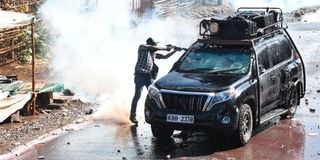Kenyans describe officer who attacked journalists as embodiment of police brutality

The Kamukunji police station-based officer firing at a car that had journalists.
Trigger-happy, angry, menacing. These are the adjectives used to describe a plainclothes police officer caught on camera targeting occupants of a vehicle that had journalists during the protests on Thursday. Four journalists were seriously injured.
Those who came in contact with the officer caught on camera targeting occupants of the vehicle shudder at the thought of having another encounter with him on Monday.
They describe the officer as the embodiment of police brutality.
The unrestrained use of force is causing journalists pain on the frontlines of the ongoing anti-government demonstrations.
On two occasions, the officer said to be attached to Kamukunji Police Station in Nairobi, has been captured strapping a black bag over his shoulders, dressed in a checked shirt and jeans, and with an earpiece, he keeps adjusting as if receiving instructions from elsewhere.
A majority of those who have encountered the policeman recall his rush to fire teargas canisters even at bystanders without provocation.
On Thursday, he was caught on camera firing a canister inside a car full of hapless journalists in broad daylight. It was a public display of impunity.
The actions of the officer who has now been largely profiled on social media did not begin on Thursday.
On March 20, he was captured by journalists in City Hallway in the company of a colleague who was dressed in a green dungaree, carrying a blue backpack full of teargas canisters and hiding his face in a gas mask and hair in a turban.
“On the first day of the protests, I was in a group of journalists around Wabera Street/ City Hall way where the police had just dispersed some demonstrators and arrested National Assembly Minority Leader Opiyo Wandayi,” recalls a journalist who covered the first round of the mass protests on March 20.
“Suddenly, this officer in plain clothes came looking agitated. There was no violence but he started firing teargas canisters without a care in the world. He seemed to be doing it for fun. He fired two in our direction despite the fact that we had our press jackets and badges on.”
The reporter says the officer then fired two more at hapless women who were passing by before walking away to join his colleagues.
A clip that has gone viral captured the officer in action on Wabera Street. Luckily, at the time, his anger was not directed at the journalists.
As the Azimio procession attempted to make its way to Jacaranda grounds on Thursday, the officer was captured on camera breaking the windshield of the vehicle journalists were using.
The journalists fled when the policeman, accompanied by three others, began firing tear gas canisters towards the vehicle.
In the process, six journalists sustained serious injuries and had to be taken to hospital.
Thinking the vehicle had occupants, the officer broke its window and fired tear gas inside.
Anger
The actions of the officer have attracted anger and consternation against the police leadership, which is yet to distance itself from the officer’s actions.
Inspector-General of Police, Japhet Koome, yesterday declined to address the matter when contacted by journalists covering the National Police Service Commission’s CEO interviews and instead published a statement commending his juniors “for acting within the confines of the law”.
“We commend all officers for their commitment, resilience and acting within the confines of the law, in their effort to quell the chaos yesterday,” Mr Koome said.
Since the anti-government protests began on March 20, journalists have been caught in the crossfire of hostile police officers and equally angry protesters.
“If it’s not an officer asking you to delete images or footage of him in action, it’s a protester attacking you for capturing his image thinking they will find themselves paraded by the Directorate of Criminal Investigations as wanted for engaging in the banned protests,” a journalist told the Saturday Nation.
“In other instances, it’s a criminal wanting to loot or damage property without facing the consequences for his actions.”
United States ambassador to Kenya, Meg Whitman, yesterday condemned the attacks on journalists.
“The United States is deeply concerned by recent reports of attacks against journalists. Protecting press freedom and safety is a cornerstone of democracy,” she tweeted.
The Media Council of Kenya expressed outrage over the attacks, describing March as the darkest month in the history of local media.
More than 25 local and international journalists have been attacked by state and non-state actors since the protests began on March 20.
The Media Council said it intends to take legal action against the National Police Service, citing deliberate attacks.
“This was not coincidental. They were deliberate acts of assault by officers against journalists who were doing their jobs,” MCK Director for Media Training and Development, Victor Bwire, said.
The opposition has equally called out the government over the attacks against journalists.




